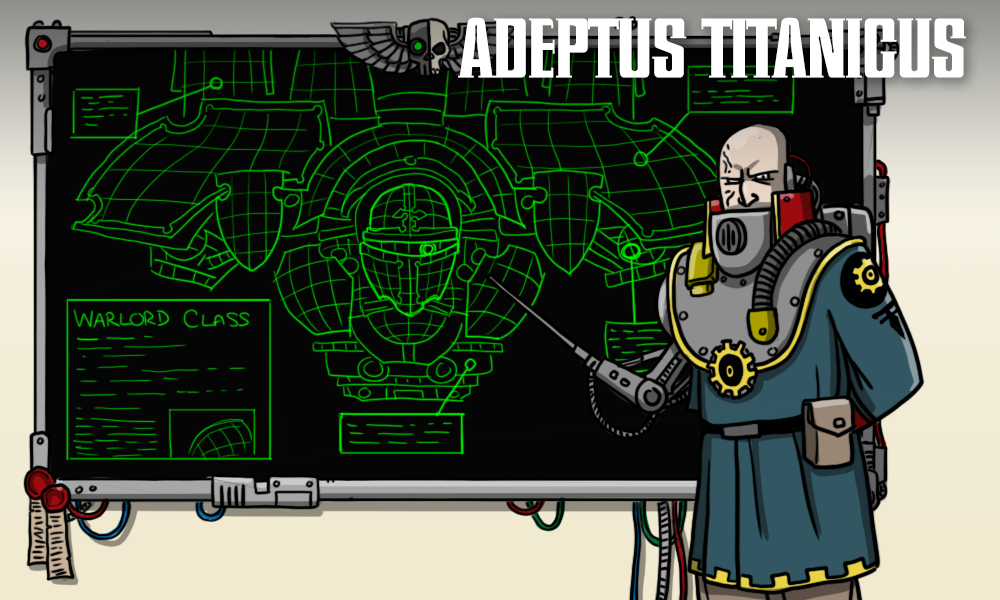It’s been a while since Doom of Molech released, and if you’ve been wondering what the AT team has been up to for the last few months, well, prepare to be amazed. Shadow & Iron is jam-packed with new content for everyone’s favorite hab-block destruction simulator, and represents what is probably the single largest expansion to the game to date. With six new Titan Legions, four new maniples to group them into, six Knight Houses for Household lists to play with, and rules for an all-new unit: the Psi-Titans of Ordo Sinister, there’s an incredible amount of new options on offer here, and we’re excited to see what players will do with these new options.
But that’s not all – even if you’re happy with your current allegiance and force disposition, you’re still going to want this book. Shadow & Iron includes rules for new weapons, including the much-anticipated Ursus Claws, a pile of new stratagems to further strengthen your forces and confound your opponents, and even campaign rules to link your games together – complete with permanent damage and crews that can gain experience and become even more terrifying over time.
It’s a great time to be a Titan Princeps, and we’re here to give you a taste of what’s new.
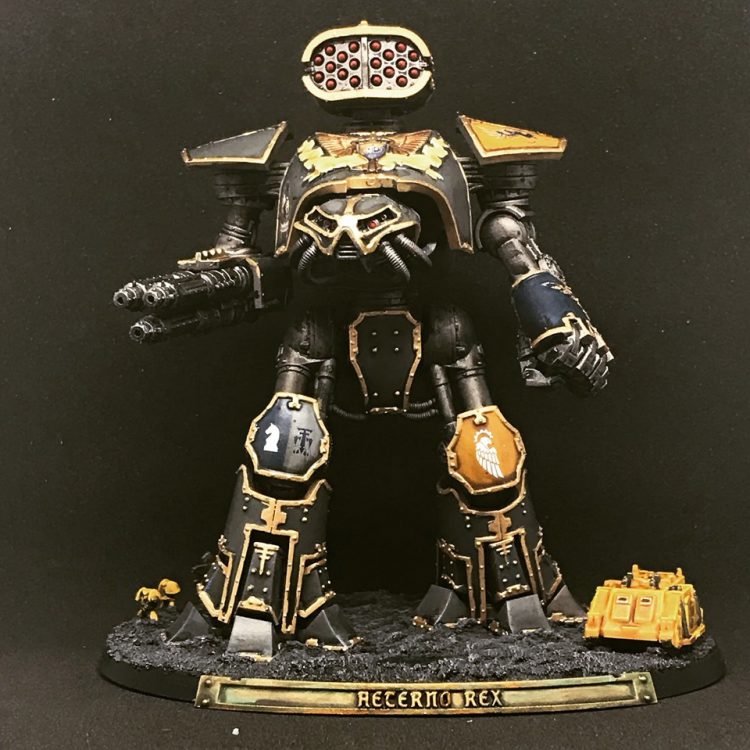
Loyalist Legios
Shadow & Iron brings three new Titan Legions for each side of the Heresy, bringing us up to a total of twenty legions with rules. Each of them has a distinct flavor and focus, and we expect to see several of these on the table in the coming months. The Loyalists are Legios Praesagius, Oberon, and Lysanda. Of the three, Praesagius stands out as the most obviously useful, but Oberon and Lysanda also bring some respectable tricks to the table.
Legio Praesagius – “True Messengers”
Legio Praesagius have some very strong traits which favour fighting their enemy at range. But unlike Legio Defensor, who deliver a single overwhelming strike to open the battle, the True Messengers direct their focus toward making precise and devastating hits on enemies who are further away. Their first trait, Pinpoint Accuracy, lets their Titans reroll location dice on attacks at long range, allowing them to more reliability finish off Titans from afar. This is complemented by their stratagem Precision Volley, which adds 1 to hit rolls for all attacks made by Praesagius Titans (regardless of maniple) at long range for a round.
While you might be tempted to load up on long-ranged Warlords or the new Warbringer Nemesis Titans with their board-spanning weapons, you might actually be better served by focusing on mid-ranged weapons like laser blasters or gatling blasters. The ability to re-roll the location die gives you about a 55% chance of landing a hit to your target’s body, which will let you fairly reliably demolish that location with concentrated fire. Consider taking a largely mid-ranged list to screen for a single fire support Warlord or Warbringer, and do what you can to keep your opponent in your weapons’ long range. Or go with a Corsiar and use your additional maneuverability to keep your opponents at exactly the range you want them.
Legio Oberon – “Death Bolts II”
Legio Oberon fought alongside the Ultramarines in the Great Crusade and apparently picked up some serious strategic know-how from hanging out with the Sons of Guilliman. They have a number of Legio and Princeps traits which involve making command checks more reliable or bypassing them entirely, and with careful maneuvering can leverage their positioning to impose a penalty on armor rolls against them. However, perhaps their most impressive trick is Strategiser, a 3-point stratagem that allows them to counter an opponent’s stratagem if it costs 2 stratagem points or less. Yes, Agents of Vect has come to Titanicus.
Legio Oberon will provide a flexible set of options that you can run in almost any maniple, though you’ll want to be laser focused on your chosen strategy since you’ll get the most use out of their abilities if you’re issuing the same orders to multiple Titans. However, your plans that lean on orders will be that much more consistent, and just the threat of Strategiser will have a huge impact on how the game plays.
Legio Lysanda – “Sentinels of the Edge”
Legio Lysanda are the most stalwart of the new Legios, with upgrades and Princeps traits that allow them to have more consistent command checks and generally greater reliability overall. Their Legio Trait Patience Beyond Measure is an interesting risk/reward tool: it allows them to yield all deployment advantages and the choice of first turn to their opponent in exchange for adding +1 to hit for any hit rolls or command checks in the first turn. Meanwhile, the Vanguard Leader Princeps trait allows all friendly Legio Lysanda Titans within 3″ of your Princeps to get the extra movement from Power to Locomotors without having to push the reactor, give you additional mobility with a few critical Titans while your other god-engines lay down supporting fire.
Lysanda is all about reliability – their tools remove or minimize variance in some unusual places, potentially opening up some strategies that would normally just be too risky to consider. We’re not convinced that they’ll wind up being as great as some of the other options in this book, but they’ve definitely got a few options that make them worth considering.
Traitor Legios
The three Traitor Legions on offer are Legios Infernus, Mordaxis, and Audax. Audax is the standout of these three, but Infernus and Mordaxis also bring some very unique tools to the table, especially when combined with certain maniples.

Legio Infernus – “Fire Masters”
Originally known as Legio Suturvora, they opted for a somewhat less subtle name. Appropriately enough, they have an affinity for fire and melta weaponry. This includes letting you place flame templates up to 2″ away from the weapon firing it (and even angle around corners!), as well as allowing your Princeps to fire a second time with a melta cannon or inferno gun once each round. If you need to open up the board so you can take advantage of these close ranged weapons, they also have the useful ability to level a piece of blocking terrain anywhere on the table during the combat phase for 1 stratagem point.
Consider smaller maniples that will let you take advantage of inferno guns and melta cannons – the Ferrox Light Maniple stands out as an obvious choice, letting you bring a few Warhounds with an inferno gun or two each, then stick your Princeps in a Reaver with a melta cannon and watch your enemy’s armor melt away. The Fire Masters could also get some great use from the Lupercal Light Maniple, combining the flexibility they have in lining up inferno gun shots with the bonuses to coordinated strikes to deal frightening amounts of damage to enemies foolish enough to stand in groups.
Legio Mordaxis – “Death Dealers”
The Death Dealers fought along side the Word Bearers, however more resemble the Death Guard in theme. They ignore movement penalties from quake or concussive weapons, have some nasty toxin-based AOE abilities, and can take a strat that gives a boost to the Damage Control phase for all their Titans.
Their Toxin Nodes wargear lets them upgrade the AOE of a smaller 3” blast to 5” at the cost of 20 points and reducing the strength by one. Unstoppable costs a whopping 3 stratagem points, but adds two additional dice to every Death Dealer’s repair rolls for a phase.
The Princeps trait Proud Protector is an interesting trait that might be worth trying out. It lets your Princeps push their reactor to strike back with one of their weapons whenever a friendly titan with 3” takes a hit to armor. To make it work, you’ll have to take some risks, but if you’re running a maniple that requires your Titans to be near one another anyway, such as a Regia, a Fortis, or the new Mandatus, enemies will think twice about attacking your Princeps or any nearby Titans.
Legio Audax (Ember Wolves)
The fan-favorite legion is here at last, and hoo boy are they nasty. The Ember Wolves are now the premier Scout Titan legion for the Traitors, and unlike Legio Solaria, they won’t even consider bringing a Reaver or Warlord. In fact, they can’t even use maniples that even optionally allow for Titans of scale 7 or higher.
That’s fine, though, as they have plenty of tricks to get maximum use out of their Warhounds, including the Stalk Unseen Legio Trait, which makes them harder to hit when they’re in cover in the first battle round. They also bring some cool legion-specific wargear, including an upgrade to the new Ursus Claws weapons that makes them a little more reliable when trying to drag down larger prey. Their Princeps traits are interesting, as well – Cull the Weak lets the Princeps re-roll failed armor rolls against a location that’s taken any Critical Damage, letting them take out crippled targets that much more effectively.
Maniples
Shadow & Iron also brings 4 new maniples with some nifty tricks to play with, including the game’s first legion-specific maniple, the Legio Audax-exclusive Canis Light Maniple. It also brings two maniples that allow you to field the new Warbringer Nemesis Titan as well as a maniple consisting of a single Warlord backed up by 2-4 Warhounds, finally opening the door to bring the game’s most iconic model in your smaller games.
Canis Light Maniple
Required Elements:
- Three Warhound Titans
Optional Elements:
- Two Warhound Titans
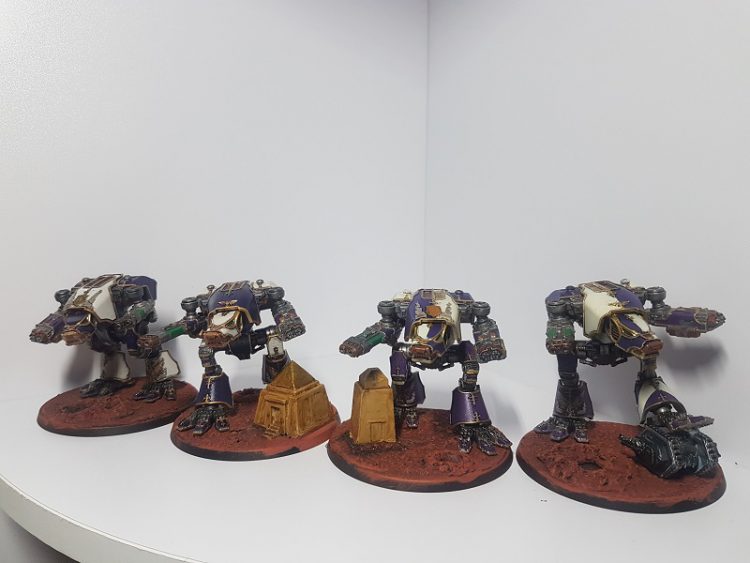
The first legion-specific maniple, the Canis Light Maniple can only include Titans from Legio Audax. This has an identical force disposition to the Lupercal Light Maniple from Titandeath, but a completely different trait: Pack Ambush. Instead of deploying your Titans, you place a Pack Ambush token for each Titan in the maniple, then wait for your opponent to deploy, then place each of your Titans within 3” of one of the Pack Ambush markers. These markers can be anywhere on the board more than 6” from your opponent’s deployment zone, but any Titans deployed outside your deployment zone have to be deployed in at least 50% cover. If you can’t, you just deploy them in your deployment zone as normal. On top of all of this, your Titans all count as having deployed first, giving you a bonus on certain deployments.
This is an incredible deployment trick that will dramatically alter the way the game is played. An Audax battlegroup in a Canis can take control of the battlefield immediately and has all the tools it needs to keep it. Keep in mind that there’s nothing in there about picking up an ambush token when you deploy a Titan near it – in other words, the tokens you set down are merely places you could put a Titan, not places you will deploy one. Use this to mess with your opponent’s head and press your advantage on the first turns to secure a quick and decisive victory.
Arcus Battleline Maniple
Required Elements:
- One Warbringer-Nemesis Titan
- Two Warhound Titans
Optional Elements:
- Two Warhound Titans
The Arcus Batteline uses its Warhounds to collect targeting data for the Warbringer further back in the field. The Warbringer in this maniple can ignore line of sight so long their target is within line of sight of one of their Warhounds, letting it put its quake cannon template anywhere it feels like, or no-scope enemies with a melta cannon clear through a hab-block. This comes with the usual -2 to hit for firing indirect, but the Warbringer’s blast weapons scatter less when targeting enemies your Warhounds can see, using a d6 rather than a d10, which means your templates are less likely to scatter entirely off their targets.
Consider taking at least one blast weapon on your Warbringer’s arms to get the most out of the more reliable scatter. Melta cannons are great, though a volcano cannon could be useful if you’re trying to take maximum advantage of the range of the quake cannon. This maniple might also pair well with the Death Dealers’ Toxin Nodes, since the increased blast radius combined with less extreme scatter distance means your volcano or melta cannon shots are more likely to find their mark, even if you fail the hit roll. Also consider Legio Fureans – with their Hunting Auspex wargear, your Warbringer will be able to shoot through walls at its full BS, robbing your opponents of the ability to hide from its powerful weaponry.
Ruptura Batteline Maniple
Required Elements:
- Two Warbringer Nemesis-Titans
- One Reaver Titan
Optional Elements:
- Two Reaver Titans
The Ruptura allows your Warbringers cover fire as your Reavers move up the field. Each round, you can choose one Reaver to move at its boosted speed without pushing its reactor, letting you close with their powerful close- and mid-ranged weapons. And every time one of your Warbringers secures an engine kill, every Reaver in the maniple can immediately make a move as though it were the movement phase. We’re excited to see what the new Warbringers can do, and this maniple will likely be an excellent way to get the most use out of them – Reaver-class arm weapons do a decent job stripping shields, and a pair of quake cannons will ensure that whatever unfortunate victim you choose will be locked down and ready to be torn apart in short order.
Legions who do well in close-to-mid range will find the Ruptura tempting. Praesagius can stagger the ranges on their Warbringers, and could put out impressive amounts of damage with laser blasters at long range despite the -1 to hit due to their ability to re-roll the location die, and building a shorter-ranged Reaver or two will help keep the opponent honest and let you maintain long range with the larger Titans. This maniple might also work well for legions that thrive in melee – Legio Vulpa in particular will appreciate being able to boost a melee Reaver’s movement without having to push its reactor, and their legion trait and wargear makes the Warbringers more of a threat if they do happen to get stuck in combat.
Mandatum Battleline Maniple
Required Elements:
- One Warlord Titan
- Two Warhound Titans
Optional Elements:
- Two Warhound Titans
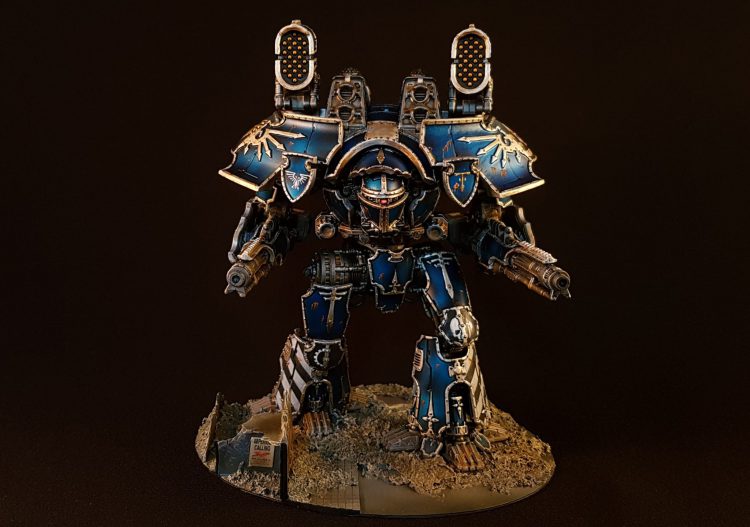
The Mandatum brings a force disposition we’re excited to see: one Warlord with a pile of Warhounds running around giving it cover. If you’ve got a Warlord and want to bring it in smaller games, this is an excellent way to make that happen, clocking it at just shy of 1000 points for the mandatory elements with an average loadout. This gives you plenty of room to add in some Household Support or another Titan or two in smaller games, something that most Warlord lists haven’t had the luxury of to this point.
The maniple’s trait is solid, even if it isn’t flashy: as long as the Warlord is alive, the Warhounds get +2 to command checks, effectively giving them the same command value as a Warlord. In addition, the Warhounds excel at running interference for the Warlord, and get +1 to hit rolls against targets within 12” of their commander. You’ll want to build your Warlord with a somewhat aggressive loadout so that you can get close enough to give the bonuses to hit rolls.
Psi-Titans
If all of this wasn’t enough, Shadow & Iron also sees the Ordo Sinister Psi-Titans joining the fray – massive machines with phenomenal psychic powers and an absolutely disgusting new weapon. Psi-Titans come at a premium, and right now the only one available is the Warlord-Sinister, which starts at 685 points and comes equipped with a Sinistramanus Tenebrae and an Arioch Titan power claw. The cost of the sinistramanus is baked in to the points upgrade, and we honestly don’t know how much of the points cost is attributable to it. It’s strength 10, ignores voids, hits automatically, and lets you call shots for free on its first target. We say first target because it fires a beam, and if it manages to take down the first Titan it hit, the beam continues through that Titan to the next target behind it and hits that.
In addition to its really cool new gun, Psi-Titans manifest psychic powers in lieu of taking orders. Some of these function like souped-up versions of standard orders – Necrotechica allows your Titan to make a repair roll with an extra die, +1 to the roll, and the ability to heal structure damage – while others are just completely different, like Death Pulse, which picks a point on the board and deals one hit with the Warp rule to everything within 8″.
All this power comes at a cost, though: if a Psi-Titan’s machine spirit would awaken as a result of failing a psychic power or firing its sinistramanus, it rolls on the new Psychic Manifestation table rather than the normal machine spirit table. The results on that table being some nasty psychic-flavored problems for you to deal with. This won’t come into play often, but when it does, it can be a huge problem.
Psi-Titans look like a ton of fun, but they’re very expensive – expect them to clock in at over 700 points – and can’t be taken as part of a maniple. They also limit the stratagems you can take – a list with a Psi-Titan cannot take any Traitor stratagems or include any Traitor Titans of Legend. If you’re a Traitor player, you may have some difficulty squeezing these into your force, but don’t fret – the Psi-Titan rules spend a decent amount of space talking about how they interact with “Corrupted” Titans and Knight Banners – expect some more cool stuff coming in future months.
New Weapons
In addition to the Warlord-Sinister’s sinistramanus tenebrae, Warhounds get some new toys as well: Ursus Claws and Natrix Shock Lances. Both are short-ranged, low strength weapons, but each also packs some nasty tricks. For starters, both weapons bypass void shields entirely, letting them apply their effects to their targets without having to pound down shields first.
Ursus Claws are the high-risk, high-reward option here. If they hit, they roll against the target’s scale rather than any location’s armor value. If the roll is equal to the scale, the target is rotated 90 degrees in a random direction. If it exceeds the scale, the target is rotated and takes 2-4 devastating hits to its legs as it’s wrenched apart by the smaller scout Titans trying to pull it down. However, if you roll a natural 1 or roll less than the target’s scale, your Titan gets jerked around, suffering a devastating hit to the legs and a hit against its Ursus Claws, potentially disabling them permanently.
The Natrix Shock Lance is even more devious – if its armor roll results in a direct hit or better, it forces its target to take the Shutdown Order and replaces any order it might have been issued. Unlike normal Shutdown orders, this one clears during the End Phase with other orders, but taking a model out of the combat phase for a turn will let you attack other enemies with impunity, or drop its shields and let you deal some early structure damage while it struggles to re-light its generator. You’ll need to use every trick in the book to compensate for its weak strength 4, but in the right list, this could be terrifying.
New Stratagems
Shadow and Iron features 18 new stratagems for all occasions, including Warp Trickery for the traitors and Desperate Measures for loyalist players. We’ve picked out a few of the stand-outs from each category, but there’s more where this came from. Look forward to some new tricks for almost any list to consider.
Warp Trickery
When all else fails, just mess around with the warp and hope for the best, right? Warp Trickery stratagems provide powerful bonuses to traitor players, though some of them are double-edged swords.
Profane Blessing (1)
Select a Titan at the beginning of the game. Once during the game, it can re-roll any number of dice from a single roll. Re-rolls are pretty hard to come by in Titanicus, and Profane Blessing is very flexible. It can ensure you either land those crucial hits or avoid your shields dropping, and since each weapon’s dice are resolved simultaneously, this strat can pay dividends when attacking with or defending against a weapon with a large dice characteristic. Never a bad stratagem to have in your arsenal, and you can even buy it multiple times if you’ve got the points to spare.
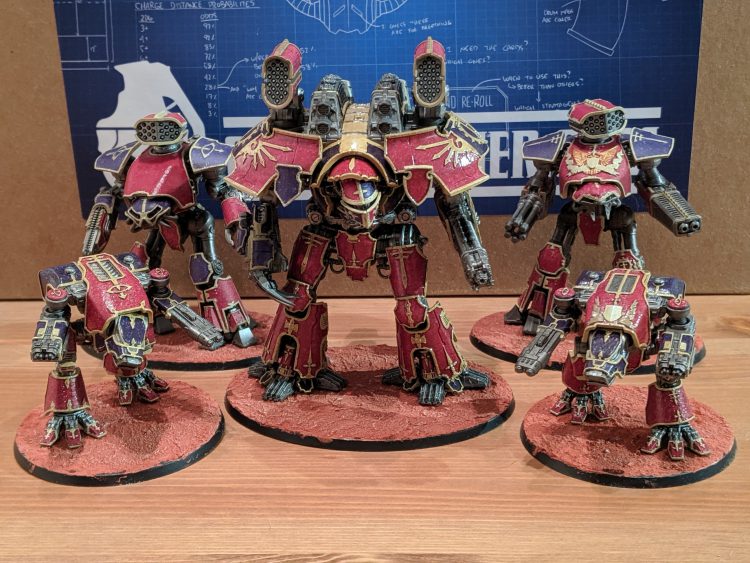
Unhallowed Ground (2)
Are you a traitor who finds it difficult to stand still? This is the stratagem for you! Play this in the first turn, and it says in effect for the entire game. Each turn, any Titans who haven’t moved at all during the movement phase take d3 S6 hits, bypassing shields and automatically hitting the legs on Titans. This will seriously make your opponent consider the risk of first firing with their fire support platforms and will hugely change up a game by making camping risky. Being thematic and changing the feel of a game without being over powered, it’s a great pick.
Desperate Measures
Loyalists don’t like to mess with the warp so much, but when confronted with the terrifying options available to the Traitors, they’ve dug deep and come up with some dirty tricks of their own. The Desperate Measures stratagems are just what they sound like – they often come into play when all seems lost or involve taking huge risks, but the payoff can be phenomenal.
Even in Death (2)
If things aren’t going so well, you can always count on one of your own Titans blowing up to set off a chain reaction which will turn the tables on your opponent. When a friendly Titan dies, this stratagem lets you roll on a modified Catastrophic damage table where your only options are Magazine Detonation or Catastrophic. Use this stratagem on a close-combat Reaver and try to take out half the table with you.
Weapons to Full (2)
For when you want to go out in a blaze of glory, but your enemy is too far away to get caught in your meltdown. Weapons to Full enables a Titan to immediately attack during the Combat phase even if it has already attacked this turn with one or all of its weapons. One catch: after each weapon fires, you roll a D10 on the Reactor Overload table, which will probably result in your own death. Worth it. Hopefully.
Tactical Support
Anyone can use a little tactical support now and again, and these stratagems provide some flexible options that can find a place in almost any list.
Concealment Barrage (1)
Able to be used either offensively or defensively, this creates a 5” LOS blocking cloud for the round on the field which can be dropped anywhere on the board without scattering at the start of any phase. This is a straight-up upgrade from Blind Barrage, and you can use this to keep an injured Titan alive, prevent an opponent’s Titan from firing any direct fire weapons, or selectively close down particular firing lanes as you see fit. Cheap, useful, and thematic.
Tracer Cloud (1)
Like Concealment Barrage, this can be played at the start of any phase and places a 5” marker on the table. Any titans within the 5” template can have attacks against them re-rolled. As we mentioned before, re-rolls are hard to come by in Titanicus and this is a fantastic tool to ensure you get those hits on a critical target. Just be careful where you drop it – if it overlaps any friendly models, your opponent will benefit from re-rolls against them as well.
Campaign Rules
The Titandeath supplement brought campaign rules to Titancus, allowing you to to fight over a series of linked games to take control of a planet, leveling up crews and scavenging wrecks between games. Shadow and Iron takes this to a whole new level with loads of options for you to run an interstellar campaign spanning the Five Hundred Worlds of Ultramar.
In addition to the previous campaign mechanics introduced in Titandeath and repeated in this book, there are many different options on how to run your campaign, plenty of mechanics for how to use the resources you’ll collect from the various worlds you conquer, and the addition of campaign rules for Knight Household lists.
There is a long list of Titan wargear available to all players, which allows you to fully tailor all of your Titans to fit your narrative. There’s a wealth of options given here and we really look forward to seeing what people out there do with the framework provided in this book – Titanicus is just waiting for someone to use it to tell a truly epic narrative, and the toolkit on offer here is surprisingly robust, offering opportunities for glorious victories, heroic last stands, and everything in between.
And More!
On top of all of this, there’s even more in this book for you to take into your games. For Knight Household players, Houses Orhlacc, Vornherr, Vyronii, Mordred, Malinax, and AErthegn all get Knightly Qualities they can bestow upon their High Scions and Seneschals, giving you more options to make your Household play the way you want it to. There are also new Narrative Missions that let you re-enact some of the most memorable battles from the Iron Crusade, with everything from pitched battles between massive forces to desperate last stands where even a single model surviving can be enough to escape defeat.
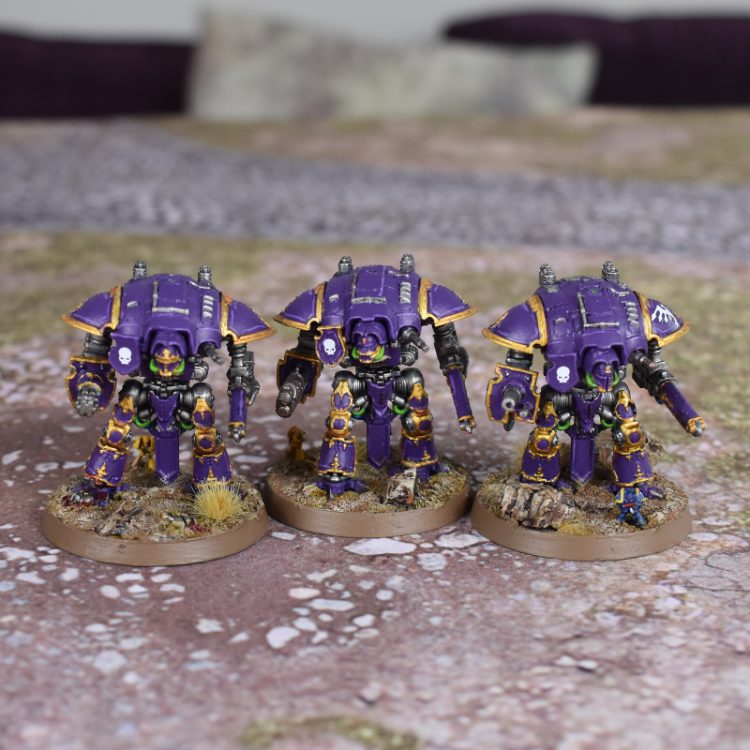
Finally, there’s the Battlefields of the Crusade of Iron, which are sets of rules for several of the Five Hundred Worlds, offering unique rules that represent the dangers of fighting on unusual terrain, with feature like blazing-hot deserts, ocean worlds, underground caverns, and even a world being overtaken by warp storms. If you’re looking to change up the game and add some variety to your games, setting a battle or two in one of these unique battlefields can be a great way to create a memorable fight – and add even more opportunities for the unexpected to get in the way of your and your opponents’ best-laid plans.
Wrapping Up
If you’re a fan of Adeptus Titanicus, this supplement is a must-buy. The sheer number of options to play with here is staggering, and we can barely contain our excitement as we wait to see how these new toys impact the game. We’ll be taking a more in-depth look at this supplement in the coming weeks, and in the meantime we’re stoked to see what new and exciting lists these rules enable.
